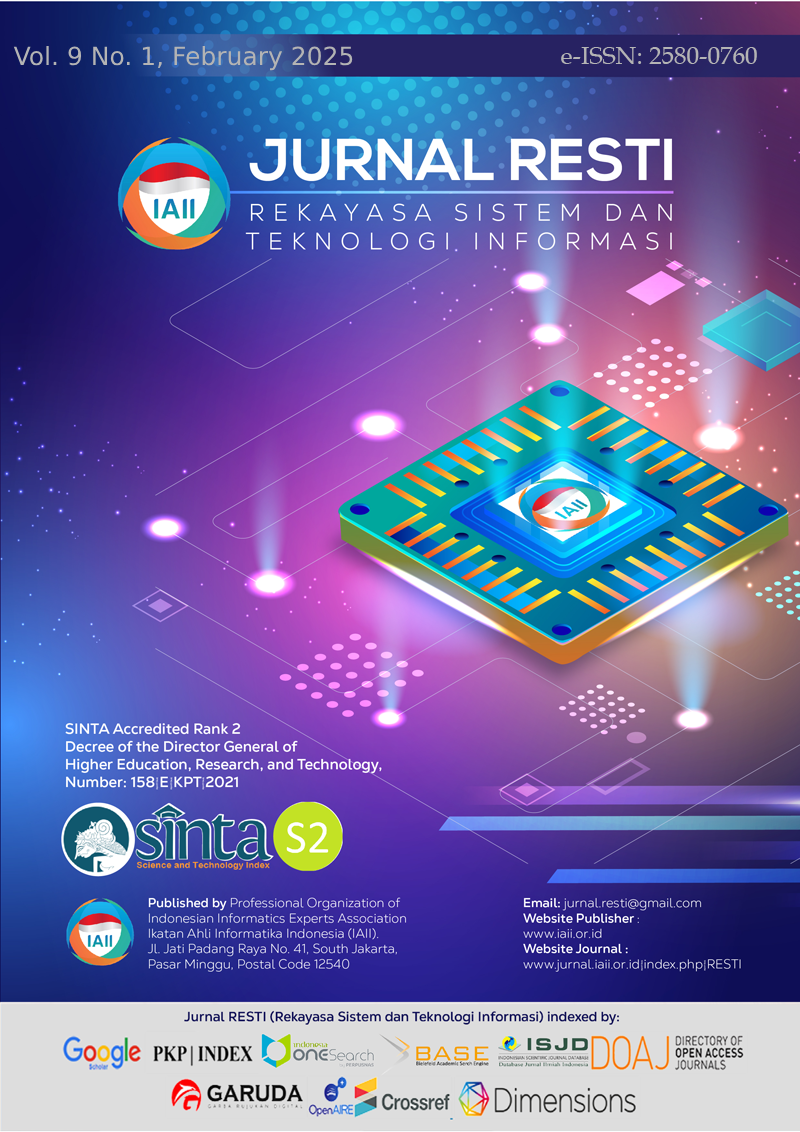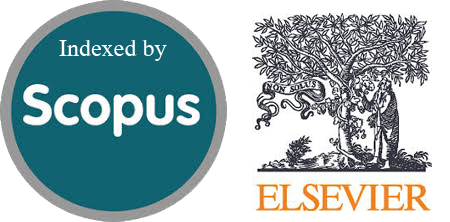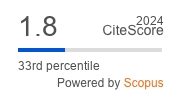CNN Performance Improvement for Classifying Stunted Facial Images Using Early Stopping Approach
Abstract
Stunting, a condition characterised by short stature, is a growth disorder caused by chronic malnutrition, which often begins in the womb. Children affected by stunting usually show different physical and cognitive characteristics compared to their peers. Research shows that these physical differences can also be observed in facial features. Because faces provide important information and are commonly studied in digital image processing, in this study, we will compare the facial image classification performance of stunted children versus normal children using various Convolutional Neural Network (CNN) architectures. The evaluated architectures include MobileNetV2, InceptionV3, VGG19, ResNet18, EfficientNetB0, and AlexNet. To improve the learning process, augmentation techniques with Haar cascade and Gaussian filters were applied so that the data set increased from 1,000 to 6,000 images. After adding the dataset, training is carried out with an early stop approach to minimise overfitting. The main aim of this research is to identify the CNN model that is most effective in differentiating facial images of stunted children from normal children. The results show that the EfficientNetB0 architecture outperforms other models, achieving 100% accuracy. Early stopping has been shown to improve training efficiency and help prevent overfitting.
Downloads
References
armik, A. Patil, and S. Zod, “Malnutrition Detection Analysis and Nutritional Treatment Using Ensemble Learning,” in Artificial Intelligence of Things, vol. 1929, R. K. Challa, G. S. Aujla, L. Mathew, A. Kumar, M. Kalra, S. L. Shimi, G. Saini, and K. Sharma, Eds., in Communications in Computer and Information Science, vol. 1929. , Cham: Springer Nature Switzerland, 2024, pp. 296–310. doi: 10.1007/978-3-031-48774-3_21.
T. R. Gadekallu, C. Iwendi, C. Wei, and Q. Xin, “Identification of malnutrition and prediction of BMI from facial images using real-time image processing and machine learning,” IET Image Process, vol. 16, pp. 647–658, 2021, Accessed: Aug. 12, 2024. [Online]. Available: ttps://pdfs.semanticscholar.org/1f59/e54001177de23c9306c4e194996825adc7be.pdf
A. R. Lakshminarayanan, B. Pavani, V. Rajeswari, S. Parthasarathy, A. A. A. Khan, and K. J. Sathick, “Malnutrition detection using convolutional neural network,” in 2021 Seventh International conference on Bio Signals, Images, and Instrumentation (ICBSII), IEEE, 2021, pp. 1–5. Accessed: Jul. 16, 2024. [Online]. Available: https://ieeexplore.ieee.org/abstract/document/9445188/
H. MohammedKhan, M. Balvert, C. Guven, and E. Postma, “Predicting Human Body Dimensions from Single Images: a first step in automatic malnutrition detection,” in CAIP 2021: Proceedings of the 1st International Conference on AI for People: Towards Sustainable AI, CAIP 2021, 20-24 November 2021, Bologna, Italy, European Alliance for Innovation, 2021, p. 48. Accessed: Jul. 17. http://dx.doi.org/10.4108/eai.20-11-2021.2314166
V. G. Biradar and K. K. Naik, “Detection of Malnutrition in Children Using Deep Learning Model,” in Smart Trends in Computing and Communications, T. Senjyu, C. So–In, and A. Joshi, Eds., Singapore: Springer Nature, 2024, pp. 35–45. doi: 10.1007/978-981-97-1323-3_4.
B. Jin, L. Cruz, and N. Gonçalves, “Deep facial diagnosis: deep transfer learning from face recognition to facial diagnosis,” IEEE Access, vol. 8, pp. 123649–123661, 2020, Accessed: Sep. 03, 2024. [Online]. Available: https://ieeexplore.ieee.org/abstract/document/9127907/
T. R. Gadekallu, C. Iwendi, C. Wei, and Q. Xin, “Identification of malnutrition and prediction of BMI from facial images using real-time image processing and machine learning,” IET Image Process, vol. 16, pp. 647–658, 2021, Accessed: Sep. 03, 2024. [Online]. Available: https://pdfs.semanticscholar.org/1f59/e54001177de23c9306c4e194996825adc7be.pdf
Y. Yunidar, R. Roslidar, M. Oktiana, Y. Yusni, N. Nasaruddin, and F. Arnia, “Classification of stunted and normal children using novel facial image database and convolutional neural network,” Radioelectronic and Computer Systems, vol. 2024, no. 1, pp. 76–86, 2024, Accessed: Jul. 17, 2024. [Online]. Available: http://nti.khai.edu/ojs/index.php/reks/article/view/reks.2024.1.07
A. Singh, H. Herunde, and F. Furtado, “Modified Haar-cascade model for face detection issues,” International journal of research in industrial engineering, vol. 9, no. 2, pp. 143–171, 2020, Accessed: Sep. 02, 2024. [Online]. Available: https://www.riejournal.com/article_107190.html
A. B. Shetty, Bhoomika, Deeksha, J. Rebeiro, and Ramyashree, “Facial recognition using Haar cascade and LBP classifiers,” Global Transitions Proceedings, vol. 2, no. 2, pp. 330–335, Nov. 2021, doi: 10.1016/j.gltp.2021.08.044.
G. Y. Kimura, D. R. Lucio, A. S. Britto Jr., and D. Menotti, “CNN Hyperparameter tuning applied to Iris Liveness Detection.” arXiv, Feb. 12, 2020. Accessed: Sep. 03, 2024. [Online]. Available: http://arxiv.org/abs/2003.00833
A. Nurhopipah and N. A. Larasati, “CNN hyperparameter optimization using random grid coarse-to-fine search for face classification,” Kinetik: Game Technology, Information System, Computer Network, Computing, Electronics, and Control, pp. 19–26, 2021, Accessed: Sep. 03, 2024. [Online]. Available: https://kinetik.umm.ac.id/index.php/kinetik/article/view/1185
A. Mumuni and F. Mumuni, “Data augmentation: A comprehensive survey of modern approaches,” Array, vol. 16, p. 100258, Dec. 2022, doi: 10.1016/j.array.2022.100258.
E. Goceri, “Medical image data augmentation: techniques, comparisons and interpretations,” Artif Intell Rev, vol. 56, no. 11, pp. 12561–12605, Nov. 2023, doi: 10.1007/s10462-023-10453-z.
G. Hu et al., “When face recognition meets with deep learning: an evaluation of convolutional neural networks for face recognition,” in Proceedings of the IEEE international conference on computer vision workshops, 2015, pp. 142–150. Accessed: Sep. 03, 2024. [Online]. Available: https://www.cv-foundation.org/openaccess/content_iccv_2015_workshops/w11/html/Hu_When_Face_Recognition_ICCV_2015_paper.html
“Mathematics | Free Full-Text | An Efficient Optimization Technique for Training Deep Neural Networks.” Accessed: Sep. 03, 2024. [Online]. Available: https://www.mdpi.com/2227-7390/11/6/1360
M. Moreira and E. Fiesler, “Neural networks with adaptive learning rate and momentum terms,” 1995, Accessed: Sep. 03, 2024. [Online]. Available: https://infoscience.epfl.ch/record/82307/files/95-04.pdf
T. S. Akheel, V. U. Shree, and S. A. Mastani, “Stochastic gradient descent linear collaborative discriminant regression classification based face recognition,” Evol. Intel., vol. 15, no. 3, pp. 1729–1743, Sep. 2022, doi: 10.1007/s12065-021-00585-y.
I. Kandel and M. Castelli, “The effect of batch size on the generalizability of the convolutional neural networks on a histopathology dataset,” ICT Express, vol. 6, no. 4, pp. 312–315, Dec. 2020, doi: 10.1016/j.icte.2020.04.010.
H. Choi, D. Choi, and H. Lee, “Early Stopping Based on Unlabeled Samples in Text Classification,” in Proceedings of the 60th Annual Meeting of the Association for Computational Linguistics (Volume 1: Long Papers), S. Muresan, P. Nakov, and A. Villavicencio, Eds., Dublin, Ireland: Association for Computational Linguistics, May 2022, pp. 708–718. doi: 10.18653/v1/2022.acl-long.52.
Copyright (c) 2025 Jurnal RESTI (Rekayasa Sistem dan Teknologi Informasi)

This work is licensed under a Creative Commons Attribution 4.0 International License.
Copyright in each article belongs to the author
- The author acknowledges that the RESTI Journal (System Engineering and Information Technology) is the first publisher to publish with a license Creative Commons Attribution 4.0 International License.
- Authors can enter writing separately, arrange the non-exclusive distribution of manuscripts that have been published in this journal into other versions (eg sent to the author's institutional repository, publication in a book, etc.), by acknowledging that the manuscript has been published for the first time in the RESTI (Rekayasa Sistem dan Teknologi Informasi) journal ;








